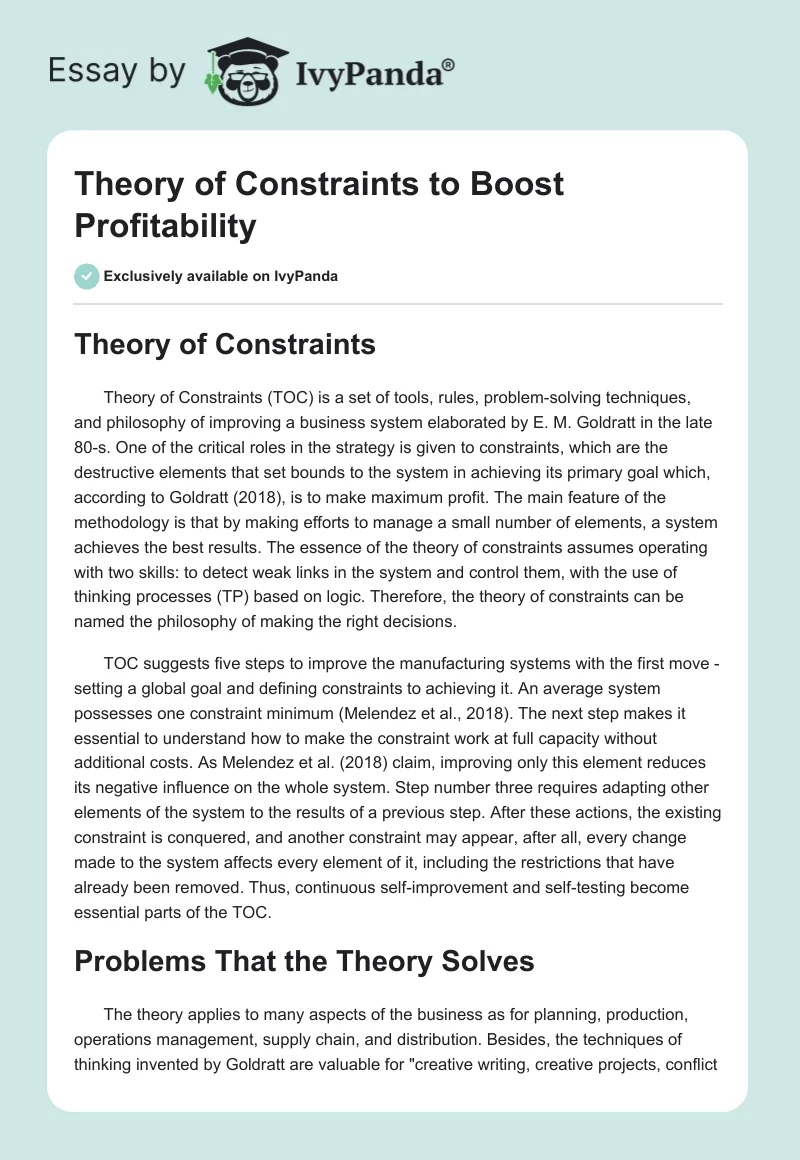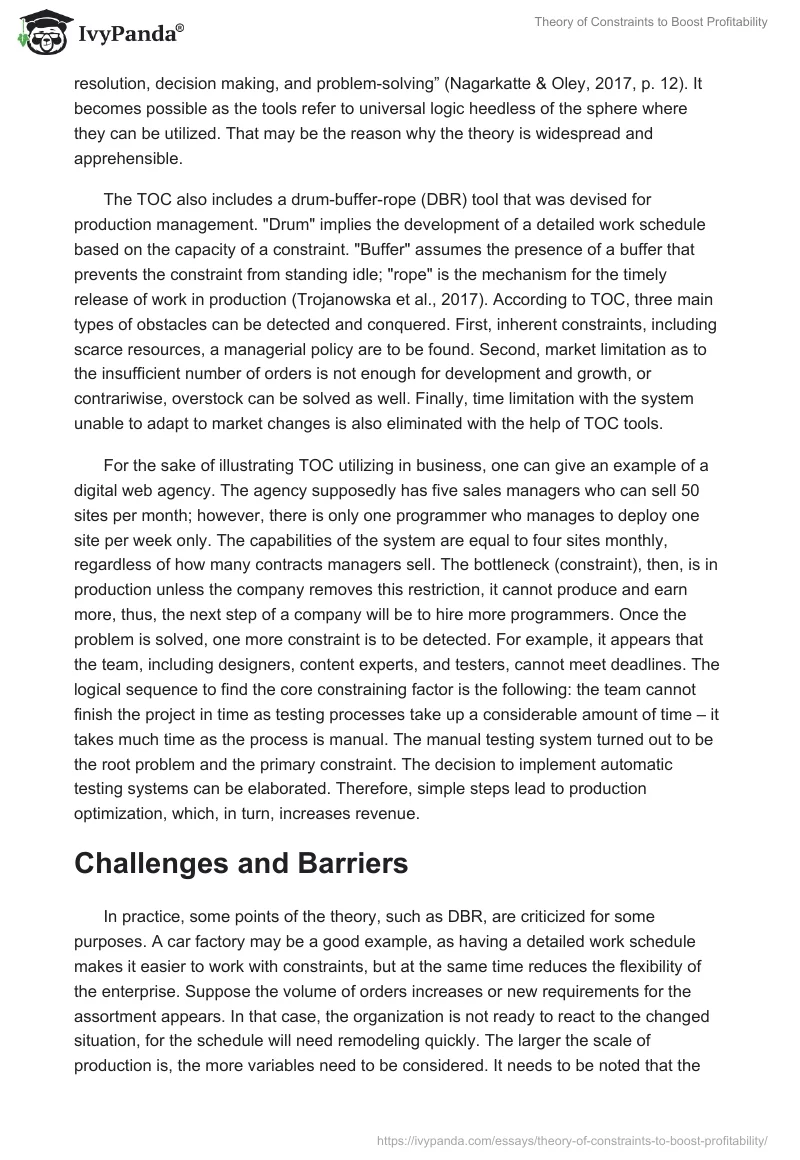Theory of Constraints
Theory of Constraints (TOC) is a set of tools, rules, problem-solving techniques, and philosophy of improving a business system elaborated by E. M. Goldratt in the late 80-s. One of the critical roles in the strategy is given to constraints, which are the destructive elements that set bounds to the system in achieving its primary goal which, according to Goldratt (2018), is to make maximum profit. The main feature of the methodology is that by making efforts to manage a small number of elements, a system achieves the best results. The essence of the theory of constraints assumes operating with two skills: to detect weak links in the system and control them, with the use of thinking processes (TP) based on logic. Therefore, the theory of constraints can be named the philosophy of making the right decisions.
TOC suggests five steps to improve the manufacturing systems with the first move – setting a global goal and defining constraints to achieving it. An average system possesses one constraint minimum (Melendez et al., 2018). The next step makes it essential to understand how to make the constraint work at full capacity without additional costs. As Melendez et al. (2018) claim, improving only this element reduces its negative influence on the whole system. Step number three requires adapting other elements of the system to the results of a previous step. After these actions, the existing constraint is conquered, and another constraint may appear, after all, every change made to the system affects every element of it, including the restrictions that have already been removed. Thus, continuous self-improvement and self-testing become essential parts of the TOC.
Problems That the Theory Solves
The theory applies to many aspects of the business as for planning, production, operations management, supply chain, and distribution. Besides, the techniques of thinking invented by Goldratt are valuable for “creative writing, creative projects, conflict resolution, decision making, and problem-solving” (Nagarkatte & Oley, 2017, p. 12). It becomes possible as the tools refer to universal logic heedless of the sphere where they can be utilized. That may be the reason why the theory is widespread and apprehensible.
The TOC also includes a drum-buffer-rope (DBR) tool that was devised for production management. “Drum” implies the development of a detailed work schedule based on the capacity of a constraint. “Buffer” assumes the presence of a buffer that prevents the constraint from standing idle; “rope” is the mechanism for the timely release of work in production (Trojanowska et al., 2017). According to TOC, three main types of obstacles can be detected and conquered. First, inherent constraints, including scarce resources, a managerial policy are to be found. Second, market limitation as to the insufficient number of orders is not enough for development and growth, or contrariwise, overstock can be solved as well. Finally, time limitation with the system unable to adapt to market changes is also eliminated with the help of TOC tools.
For the sake of illustrating TOC utilizing in business, one can give an example of a digital web agency. The agency supposedly has five sales managers who can sell 50 sites per month; however, there is only one programmer who manages to deploy one site per week only. The capabilities of the system are equal to four sites monthly, regardless of how many contracts managers sell. The bottleneck (constraint), then, is in production unless the company removes this restriction, it cannot produce and earn more, thus, the next step of a company will be to hire more programmers. Once the problem is solved, one more constraint is to be detected. For example, it appears that the team, including designers, content experts, and testers, cannot meet deadlines. The logical sequence to find the core constraining factor is the following: the team cannot finish the project in time as testing processes take up a considerable amount of time – it takes much time as the process is manual. The manual testing system turned out to be the root problem and the primary constraint. The decision to implement automatic testing systems can be elaborated. Therefore, simple steps lead to production optimization, which, in turn, increases revenue.
Challenges and Barriers
In practice, some points of the theory, such as DBR, are criticized for some purposes. A car factory may be a good example, as having a detailed work schedule makes it easier to work with constraints, but at the same time reduces the flexibility of the enterprise. Suppose the volume of orders increases or new requirements for the assortment appears. In that case, the organization is not ready to react to the changed situation, for the schedule will need remodeling quickly. The larger the scale of production is, the more variables need to be considered. It needs to be noted that the buffer – drum – rope concept was developed at the end of the last century, so in today’s conditions, it does not fully allow all factors to be taken into account. However, the research conducted by Dr. Melendez et al. (2018) shows that over the past five years, the number of publications concerning TOC and its potential for a modern business has increased from 25 % to 75 %. Consequently, companies and enterprises consider the strategy to be of help in managing production processes.
Recommendations
The main challenge comes with the application of the theory to production processes. Nowadays, TOC is “an overall theory for running an organization” (Panizzolo, 2016, p. 16). TOC proved to be beneficial at manufacturing lead time and cycle time managing, and inventory reduction. The most valid conclusion, thus, is to combine the TOC with other business strategies. An excellent example of TOC’s use at production organization is the Inditex brand better known by the brands Zara, Massimo Dutti, Bershka, and others. Amancio Ortega, the owner, adhered to the combination of such strategies as lean production, TOC, conscious fashion (Berbiche et al., 2020). Inditex was able to bypass competitors by several steps in terms of clothing release speed. TOC is successfully applied to logistics in Inditex, where goods are distributed according to a centralized scheme. The scheme is that the stores worldwide receive products directly from central warehouses in Spain, with accurate models, sizes, and colors pre-ordered by sales managers from each store. The delivery system has been worked out so clearly that new products reach European stores within 24 hours and stores in the USA and Asia within 48 hours. Thus, the company satisfies consumer demands and mitigates the loss due to fewer unsold items.
Conclusion
Therefore, the Theory of Constraints works at its fullest and proves to be of greatest practical utility for the mature companies with the interconnected chain of production processes or start-ups that need to build up that chain anew. One way to overcome the difficulties connected with implementing the TOC is to combine it with other existing strategies, for example, lean manufacturing, management by ROI, and Six-sigma (Koblasa et al., 2019). On the whole, the theory of constraints answers three essential questions in business: What to change? What to replace it with? How to manage the change? The answers to these questions allow achieving results without too much effort and additional costs.
References
Berbiche, N., Hlyal, M., & El Alami, J. (2020). Exponential success through integrated supply chain optimization, ecomotional intelligence, and reputation-based leadership: Zara model. IOP Conference Series: Materials Science and Engineering, 827. Web.
Goldratt, E. M., Zimmerman, D. J., & Motter, D. (2018). The goal: A business graphic novel. North River Press.
Koblasa, F., Šírová, E., & Králíková, R. (2019). The use of process thinking in the industrial practice–Preliminary survey. Tehnički Vjesnik, 26(3), 786-792. Web.
Melendez, J. R., Zoghbe, Y. A., Malvacias, A. M., Almeida, G. A., & Layana, J. (2018). Theory of Constraints: A systematic review from the management context. Revista ESPACIOS, 39(48). Web.
Nagarkatte, U. P., & Oley, N. (2017). Theory of constraints: Creative problem-solving. Taylor & Francis.
Panizzolo, R. (2016). Theory of Constraints (TOC) Production and Manufacturing Performance. International Journal of Industrial Engineering and Management (IJIEM), 7(1), 15–23. Web.
Trojanowska, J., Kolinski, A., Varela, M. L. R., & Machado, J. (2017). The use of theory of constraints to improve production efficiency–Industrial practice and research results. The proceedings of 24th International Conference on Production Research. DEStech Transactions on Engineering and Technology Research. Web.


